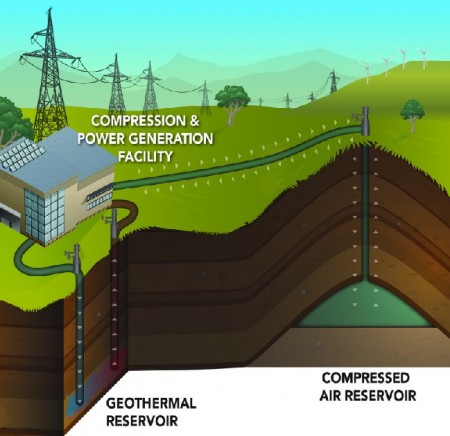May
21
Using wind energy the PNNL calculates enough wind energy could be stored for about 85,000 homes each month to be stored in porous rocks deep underground for later use.
Analysis identified two particularly promising locations in eastern Washington (a pdf download). One location, called the Yakima Minerals Site, is about 10 miles north of Selah, Wash., in an area called the Yakima Canyon. The second, called the Columbia Hills Site, is just north of Boardman, Ore., on the Washington side of the Columbia River.
For the Yakima Minerals Site the research team devised a different kind of compressed air energy storage facility: one that uses geothermal energy. This hybrid facility would extract geothermal heat from deep underground to power a chiller that would cool the facility’s air compressors, making them more efficient. Geothermal energy would also re-heat the air as it returns to the surface.

PNNL Wind Compressed Air Geothermal Energy Production and Storage Diagram. Click image for the largest view.
The other site at Columbia Hills could access a nearby natural gas pipeline, making it a good fit for a conventional compressed air energy facility. Such a conventional facility would burn a small amount of natural gas to heat compressed air that’s released from underground storage. The heated air would then generate more than twice the power than a typical natural gas power plant.
PNNL Laboratory Fellow and project leader Pete McGrail said, “Combining geothermal energy with compressed air energy storage is a creative concept that was developed to tackle engineering issues at the Yakima Minerals Site. Our hybrid facility concept significantly expands geothermal energy beyond its traditional use as a renewable baseload power generation technology.”
Compressed air energy storage plants work under a basic premise. When power is abundant, it’s drawn from the electric grid and used to power a large air compressor, which pushes pressurized air into an underground geologic storage structure. Later, when power demand is high, the stored air is released back up to the surface, where it is heated and rushes through turbines to generate electricity. Compressed air energy storage plants can re-generate as much as 80 percent of the electricity they take in.
The world’s two existing compressed air energy storage plants, one in Alabama, the other in Germany, use abandoned industrial salt caverns to store excess electricity. The PNNL-BPA study examined a different approach: using natural, porous rock reservoirs that are deep underground to store renewable energy.
Interest in the technology has increased greatly in the past decade as utilities and others seek better ways to integrate renewable energy onto the power grid. About 13 percent, or nearly 8,600 megawatts, of the Northwest’s power supply comes from of wind. This prompted BPA and PNNL to investigate whether the technology could be used in the Northwest.
To find potential sites, the research team reviewed the Columbia Plateau Province, a thick layer of volcanic basalt rock that covers much of the region. The team looked for underground basalt reservoirs that were at least 1,500 feet deep, 30 feet thick and close to high-voltage transmission lines, among other criteria.
They then examined public data from wells drilled for gas exploration or research at the Hanford Site in southeastern Washington. Well data was plugged into PNNL’s STOMP computer model, which simulates the movement of fluids below ground, to determine how much air the various sites under consideration could reliably hold and return to the surface.
The study indicates both facilities could provide energy storage during extended periods of time. This could especially help the Northwest during the spring, when sometimes there is more wind and hydroelectric power than the region can absorb. The combination of heavy runoff from melting snow and a large amount of wind, which often blows at night when demand for electricity is low, can spike power production in the region. Power system managers have a few options to keep the regional power grid stable in such a situation, including reducing power generation or storing the excess power supply. Energy storage technologies such as compressed air energy storage can help the region make the most of its excess clean energy production.
Working with the Northwest Power and Conservation Council, BPA will now use the performance and economic data from the study to perform an in-depth analysis of the net benefits compressed air energy storage could bring to the Pacific Northwest. The results could be used by one or more regional utilities to develop a commercial compressed air energy storage demonstration project.
It’s good to see some progress on storing wind energy. The wind business is a wholly synthetic market and investor arena that should make investors quite nervous. Wind on its own merits wouldn’t raise any investment at all. Mandates, tax incentives and giveaways keep the business afloat much to the consternation of many, especially the green eyeshade types.
Perhaps the wind business can find a valid economic reason for being using the hybrid approach and perhaps with a boost from natural gas or even as a natural gas extender. But the industry needs to keep the pressure on – someday the government special deals and consumer’s reaction to the real costs could be an industrial disaster.
For more info and additional visuals try the PNNL page.
Comments
3 Comments so far


WOW just what I was searching for. Came here by searching for structured annuity settlement
What a material of un-ambiguity and preserveness of precious experience about unexpected feelings.
It seems to me that the energy storage has become an urgent problem. I think it’s caused by the increase of the alternative energy market share. Here’s an interesting article I read recently on how the renewable energy surplus can be stored http://dailyfusion.net/2013/07/new-electrical-grid-energy-storage-technologies-review-10617/ . The PNNL-BPA projects is also mentioned in it.